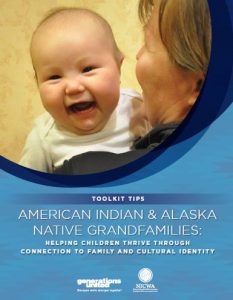About 2.5 million children in the United States live in grandfamilies or kinship families, which are families in which children are being raised by grandparents, other extended family members, or adults with whom they have a close family-like relationship. American Indian and Alaska Native children are more likely to live in grandfamilies than children in any other racial or ethnic group. While American Indian and Alaska Native children make up one percent of all children in the United States, they comprise over eight percent of all children in grandfamilies and two percent of all children in state foster care systems.
This resource is designed as a quick reference tool for practitioners and advocates working with grandfamilies and kinship families who identify as American Indian or Alaska Native. It is meant to help them provide services in a way that is culturally sensitive and effective. It also serves as a reference guide for staff orientation/training to work in these communities. The content of this resource is based on the complementary toolkit by Generations United and the National Indian Child Welfare Association, which provides additional detailed information, resources, references, and infographics. The toolkit also includes definitions and explanations of key terms used in this resource.
For more information, download the full toolkit.
 Access the tip sheet.
Access the tip sheet.